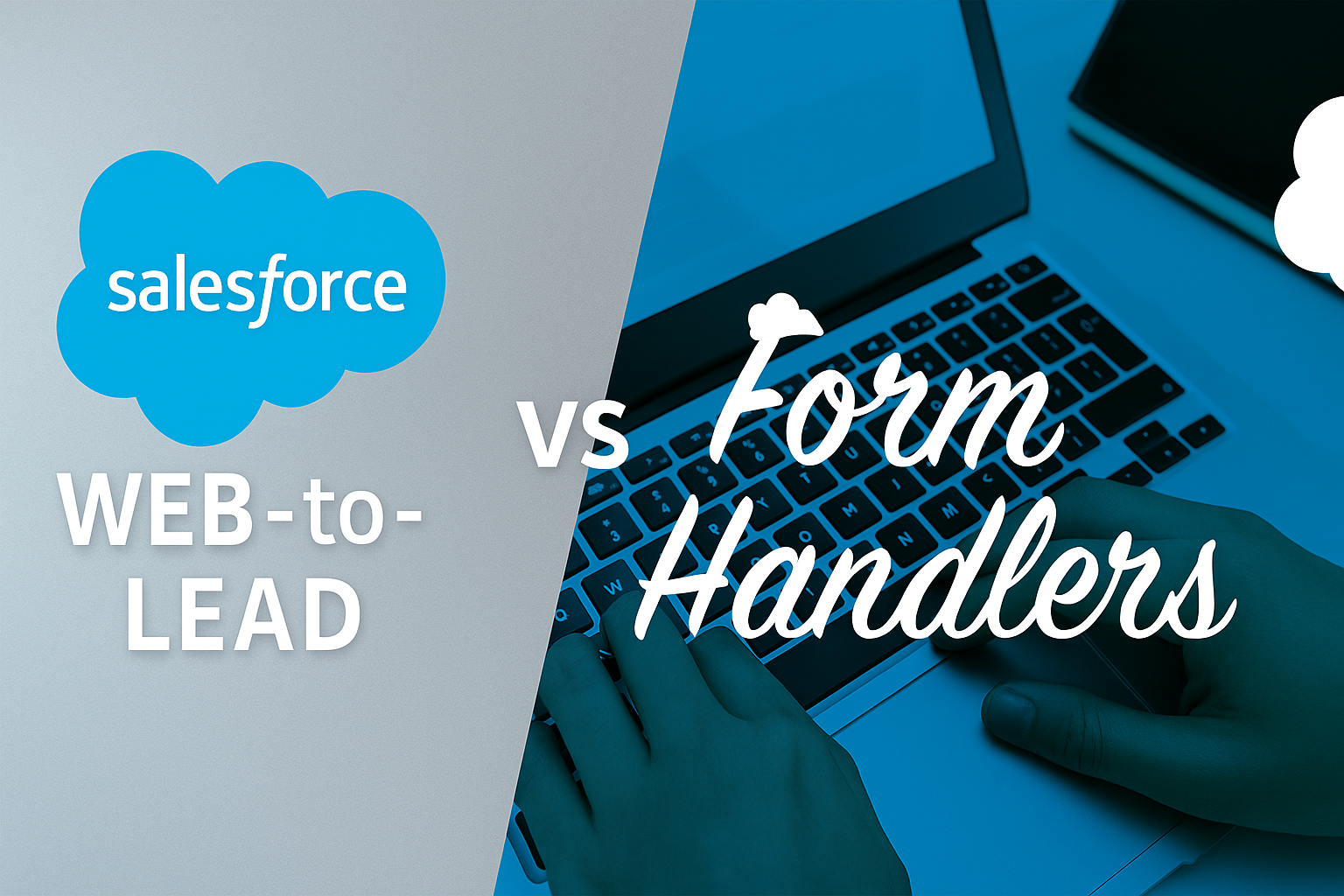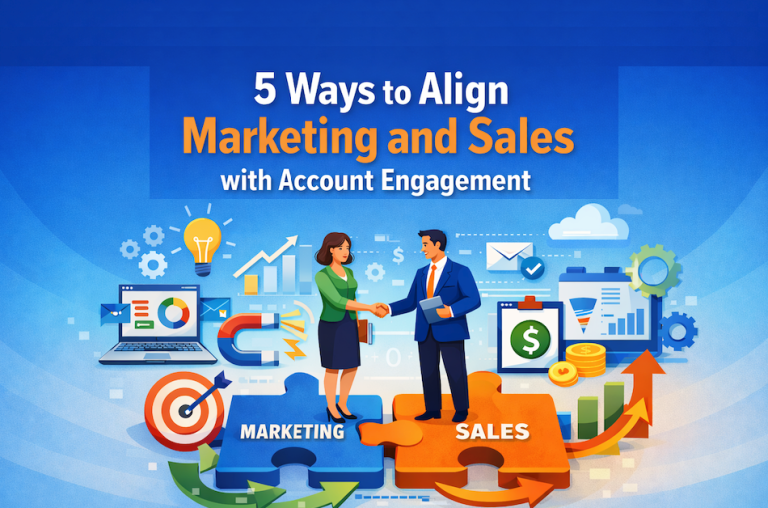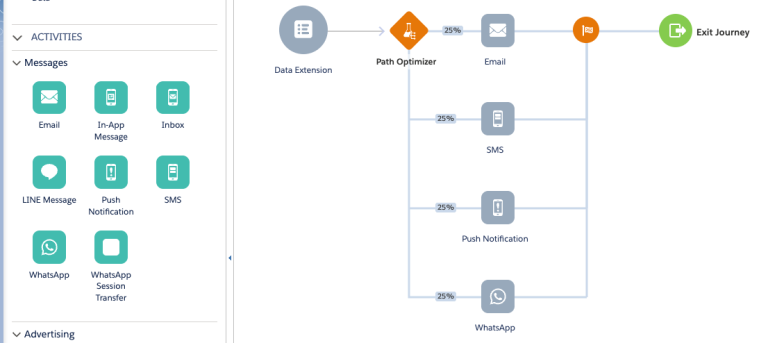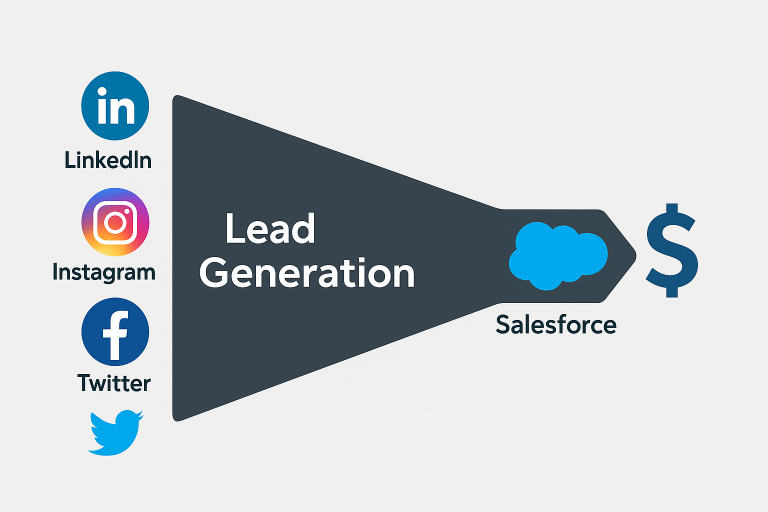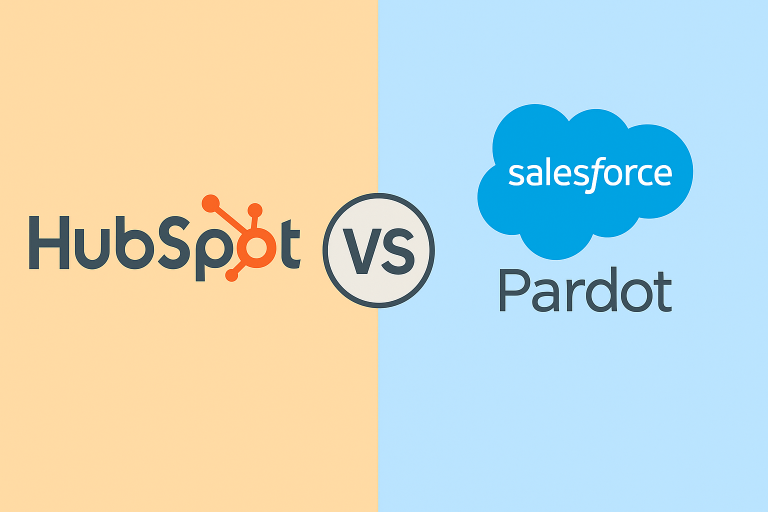Salesforce Web-to-Lead vs. Pardot Form Handler – A Feature Comparison
Introduction: Web-to-Lead (W2L) is a native Salesforce Sales Cloud feature that captures website form submissions and creates new Lead records in Salesforce directly.
In contrast, a Pardot Form Handler (part of Salesforce Pardot, a.k.a. Marketing Cloud Account Engagement) allows you to use your own website forms and post the data to Pardot; Pardot then creates or updates a Prospect and syncs it to Salesforce (usually as a Lead) via the Pardot-Salesforce connector.
Both tools serve to collect leads, but they operate differently. Below, we compare W2L and Pardot Form Handlers across key dimensions, highlighting the pros and cons of each.
Technical Setup Complexity
- Salesforce Web-to-Lead:
Setting up Web-to-Lead is straightforward – admins generate an HTML form snippet in Salesforce and embed it on the website. No additional integrations are required since the form posts directly into Salesforce. This simplicity can speed up deployment.
However, the generated form is very bare-bones. Customizing the form’s look or adding validation requires manual coding (HTML/CSS/JavaScript). In practice, you often need a web developer to style the form and implement field validations beyond the basics.
In short, basic setup is easy, but achieving a polished, branded form with interactive features demands extra development effort. - Pardot Form Handler:
Using a Pardot form handler involves a bit more initial configuration but offers flexibility. You create the form handler in Pardot by defining the fields to capture, and Pardot provides an endpoint URL (post URL) and snippet to include in your form’s code. Implementing it means modifying your existing web form (or building a new one) to post to that Pardot URL.
This requires coordination with a web developer or webmaster to ensure field names/IDs match exactly between the site form and Pardot, and to handle any extras like passing UTM parameters or setting up redirects.
The upside is that you can keep your current form UX/design – no need to embed an iframe or use Salesforce’s form; Pardot will accept data from your form.
Overall, setup is moderately complex: you must be comfortable editing form HTML and possibly writing scripts for things like error handling or field pre-fill (since Pardot form handlers are one-way). Once configured, it leverages your existing forms rather than forcing a new form UI.
Data Syncing Behavior and Accuracy
- Salesforce Web-to-Lead:
Web-to-Lead submissions are sent directly into Salesforce in real time, creating a new Lead immediately for each submission. There’s no syncing delay or intermediary – the data is instantly in your CRM for sales to see. However, Web-to-Lead has some limitations around volume and data integrity. Salesforce imposes a limit of 500 leads per 24 hours via Web-to-Lead (excess submissions are queued or emailed for later processing). This daily cap isn’t an issue for many businesses, but high-traffic campaigns might hit it. More critically, Web-to-Lead does not check for duplicates or existing records – every form submission blindly creates a new Lead record salesforceben.com. If the same person submits twice, you’ll get duplicate leads (unless you have Salesforce duplicate rules to catch it, which could at best warn or block but then the form submitter might see an error). This indiscriminate record creation means data can get messy.
Web-to-Lead also won’t reject bad data: any junk or malformed entries will become lead records unless you add front-end validation. (All data validation has to be coded in the form itself or via Salesforce duplicate/validation rules).
On a positive note, you can enable a CAPTCHA to reduce spam submissions – Salesforce supports adding reCAPTCHA to Web-to-Lead forms to filter bots.
In summary, the sync is immediate and reliable, but data accuracy can suffer from duplicates and “garbage in” if you don’t implement your own checks. - Pardot Form Handler:
With form handlers, submissions hit Pardot first, then sync to Salesforce, introducing a slight delay but improving data hygiene.
Pardot will create or update a Prospect record upon form submission. Pardot uses email address as the unique identifier, which means it will not create duplicate prospects for the same email and will also avoid creating duplicate Salesforce leads/contacts in most cases.
When a Pardot prospect syncs to Salesforce, the system checks if there’s an existing Salesforce Contact with that email, then if there’s an existing Lead with that email; if found, Pardot will update the existing record instead of making a new lead. Only if no matching record exists will it create a new Lead in Salesforce.
This built-in de-duplication by email helps maintain data accuracy (one lead/contact per person, rather than many duplicates). To get the data into Salesforce, the Pardot prospect must be assigned to a user or queue (or otherwise set to sync) – typically you’d use a Pardot completion action or automation rule to assign the prospect as soon as they submit the form. Assignment triggers an immediate sync to Salesforce.
In practice, the sync is near real-time: Pardot’s connector checks for changes every few minutes, and assignment causes an almost immediate push, so the lead will appear in Salesforce shortly after submission (usually within 1–2 minutes, if not faster).
An advantage here is that Pardot captures the lead’s activity data: when the prospect is created, Pardot ties their submission and prior website browsing history (via tracking cookie) to their record. All that behavioral data (e.g. pages visited, form conversions) is recorded in Pardot and can be synced or viewed in Salesforce, giving a richer picture of the lead.
Also, Pardot imposes no fixed daily submission limit – it’s built for marketing scale. On the downside, this method is dependent on the Pardot-Salesforce connector functioning; a rare connector error could delay sync (though this is uncommon if the integration is set up properly).
In summary, Pardot form handlers provide accurate syncing (no duplicate spam leads) and capture more data about lead interactions, at the cost of a minor delay in Salesforce visibility versus W2L’s instant insert.
Reporting Capabilities
- Salesforce Web-to-Lead:
Web-to-Lead on its own provides very limited reporting for marketers.
The tool doesn’t track form views, abandonment rates, or conversion metrics – it simply generates leads in Salesforce. Any analysis of those leads has to be done with standard Salesforce reports or dashboards.
For example, you can report on how many leads came in over time, lead source breakdowns, or campaign attribution if you passed a campaign ID or source field with the form. Since leads are created directly in CRM, no inquiries are lost, and you can at least measure total leads and downstream conversion (lead-to-opportunity) within Salesforce.
In fact, using W2L means all data is in one place, which Salesforce touts as giving “better reporting on lead flow” than if leads were scattered or emailed elsewhere.
However, you don’t get webform-specific analytics out of the box. There is no concept of a form performance report (e.g. view-to-submit conversion rate, field drop-off, etc.) in Salesforce without integrating a separate tool. Essentially, Web-to-Lead supplies raw data to your CRM, but marketing users might miss the finer-grained insights – you’d need to rely on external analytics (like Google Analytics for page views, etc.) or the Pardot campaign reports (if using Pardot tracking) to analyze the form’s effectiveness. - Pardot Form Handler:
Pardot form handlers offer more marketing-centric reporting than W2L.
In Pardot’s interface, each form handler has basic metrics: the total number of submissions, number of unique submissions (i.e. counting one per prospect), and “conversions” (typically meaning how many prospects were created via that handler). This allows you to gauge the form’s usage and contribution to new prospects.
For instance, you could see that a form had 100 submissions from 80 different prospects, resulting in 60 new prospects (conversions).
This is useful for campaign tracking. (By contrast, Web-to-Lead would just show 100 leads in Salesforce and you’d have to deduplicate or guess new vs. existing.)
That said, Pardot form handlers do not track form impressions or views – because the form itself is external. Only actual submissions are recorded (Pardot can’t natively report on how many people saw your non-Pardot form or attempted it without submitting).
Pardot’s own hosted forms do track views, but with form handlers you sacrifice that detail. Still, you can combine Pardot’s submission data with page view data (if the landing page is tracked in Pardot/Analytics) to calculate conversion rates manually.
Another reporting advantage of using Pardot is that prospects captured can be tied into Connected Campaigns – Pardot will associate the prospect with a Pardot campaign (often mapped to a Salesforce Campaign) on first submission, so you get first-touch attribution. You can leverage Pardot’s Campaign reports or Engagement reports to see how these form-fill leads progress.
In short, Pardot form handlers give you some built-in form metrics (submissions, conversion counts) and integrate the data into Pardot’s analytics ecosystem, whereas Web-to-Lead alone requires piecing that insight together manually.
Integration with CRM and Automation Tools
- Salesforce Web-to-Lead:
Being a native feature, Web-to-Lead is fully integrated into Salesforce CRM. Submissions become Salesforce Lead records with no middleware. This means all of Salesforce’s automation tools can fire immediately.
For example, you can have Lead Assignment Rules route the incoming lead to the correct owner or queue based on geography, product interest, etc., as soon as it’s created. You can set up Lead Auto-Response Rules to send an immediate confirmation email from Salesforce to the person who submitted (using different email templates based on the submission criteria). Standard Salesforce workflows or Process Builder/Flow can also trigger off the new Lead (e.g. creating a follow-up Task or notifying a specific user).
In other words, W2L plugs straight into the CRM workflow – “automations in Salesforce” (like autoresponders and assignments) are kicked off seamlessly by these web leads.
Additionally, Web-to-Lead can pass through certain parameters that facilitate integration; for instance, you can include a hidden field for Campaign ID so that the lead is automatically added as a Campaign member on creation. This is useful for tying leads to marketing campaigns in Salesforce. Integration with other systems (outside Salesforce) isn’t provided out-of-box – you’d handle that within Salesforce (for example, using integrations on the Lead object or Zapier that trigger when a new lead is created).
The key point is that W2L requires no external connectors or platforms: fewer points of failure and no extra cost, since it’s part of Salesforce already. The trade-off is that it doesn’t natively integrate with marketing automation processes (if you have Pardot, those leads will sync into Pardot anyway, but they initially bypass Pardot until after they’re in CRM). - Pardot Form Handler:
Pardot form handlers integrate the web form with Salesforce via the Pardot <-> Salesforce connector. Once a prospect submits the form, Pardot takes over: you can immediately execute Pardot automation on that prospect, and then Pardot will sync the data to Salesforce according to your connector rules.
In practice, this means you have two layers of integration/automation: Pardot’s automation tools and then Salesforce’s. On the Pardot side, you can set up Completion Actions on the form handler to do things like send the person a thank-you email (using a Pardot email template), add them to a Pardot list or nurture program, adjust their score or grade, notify internal users (e.g. email an alert to the sales rep or BDR team), and even assign the prospect to a user or queue in Salesforce. These actions happen as soon as the form is submitted in Pardot, giving a very flexible marketing response (beyond the simpler Salesforce auto-response email). When it comes to pushing to CRM, you can choose how Pardot assigns the prospect for Salesforce syncing.
Pardot can either directly assign a specific user (or a queue) as owner, or it can defer to the Salesforce active assignment rule on lead creation. The latter is powerful because you can maintain your complex Salesforce lead routing logic – Pardot will create the lead in Salesforce without an owner, causing your assignment rules to run just as they would for Web-to-Lead submissions.
This means integration with Salesforce’s sales process is smooth: you don’t lose any assignment or workflow capabilities; Pardot is simply feeding leads into Salesforce in a controlled way.
Moreover, Pardot can automatically add the prospect to a Salesforce Campaign of your choice (via completion action) so that sales users see campaign attribution on the lead, aligning with your marketing efforts. The net effect is a highly integrated approach: marketing can react instantly in Pardot (nurture or notify or tag the lead) and then the lead appears in Salesforce for sales to engage, with all the usual CRM automations (like tasks or escalations) kicking in once it’s there. The integration does introduce an extra moving part (the connector), but it’s a well-supported link between Pardot and Salesforce.
In summary, form handlers integrate with CRM indirectly but effectively – you gain Pardot’s automation capabilities on top of the standard CRM integration. The lead may arrive a minute later in Salesforce than via W2L, but it comes enriched (with Pardot campaign info, tags, etc.) and still triggers Salesforce workflows on arrival.
Flexibility and Customization
- Salesforce Web-to-Lead:
Web-to-Lead forms are basic by design. They are essentially a simple HTML<form>that posts to Salesforce – there’s no dynamic behavior provided by Salesforce beyond that submission. Out-of-the-box, W2L forms support only straightforward field capture.
This means features like multi-step forms, conditional logic (show/hide fields based on answers), file uploads, or interactive elements are not supported natively.
If you require those, you’d have to custom-build them or use a third-party form tool. You can customize a W2L form’s appearance and some behavior, but only by editing the code manually.
For instance, you can add your own HTML/CSS to change the layout or styling, and use JavaScript for form validation or interactivity (e.g., verifying an email format on the client side, or adding a character counter). Salesforce doesn’t remember or host these forms – you generate the code and then you own it.
That gives you freedom to modify it, but all maintenance is manual (if you add a new field in Salesforce you must update your form HTML yourself; Salesforce won’t auto-update it).
Web-to-Lead also cannot do things like pre-fill a returning visitor’s info or prevent duplicate submission – every hit is treated as new (it’s stateless).
In fact, W2L has no mechanism to update an existing Lead record; it only ever creates new leads.
So you can’t use it, for example, to create a profile update form for existing customers. On the positive side, W2L being just HTML means it can be embedded or tweaked in any way you want if you have the coding skills. There’s no dependency on external scripts (except the optional CAPTCHA).
It also supports all Salesforce lead fields (standard and custom) – you choose which fields to include when generating it.
For spam control or special needs, Salesforce allows adding a reCAPTCHA v2 to the form, and you could add hidden fields (like a honeypot trap or default lead source) in the HTML as needed.
In summary, W2L is not very feature-rich or adaptive (compared to modern form builders), but it’s a blank canvas that a developer can enhance. Many organizations find its limitations significant if they want a more engaging form experience, often leading them to consider third-party forms or Pardot for extra flexibility. - Pardot Form Handler:
Pardot form handlers offer maximum flexibility on the front-end because you’re using your own form. You can design and build the form in any way you see fit – it could be a form on your CMS (WordPress, Drupal, etc.), a custom-coded form, a pop-up form, or even a form from another service like FormAssembly or Typeform – and Pardot will accept the submission as long as the field names and posting method match.
This means you can have advanced features like multi-page wizards, interactive questions, or custom validations without Pardot imposing any limits (the form experience is entirely in your hands). Many third-party form tools and libraries provide far richer UI/UX options than Salesforce’s native form, and form handlers let you leverage those while still sending data to Pardot.
Moreover, form handlers are flexible in terms of data handling. You do not have to send every form field into Pardot – Pardot lets you map only the fields you need for marketing.
For example, if your form collects a password or credit card for account creation, you shouldn’t store that in Pardot; with a form handler, you can have your web server process those sensitive fields separately and simply omit them from the Pardot submission.
Pardot will record the fields it recognizes and ignore the rest.
This selective mapping is useful for compliance (avoiding personal data you don’t want in Pardot) and for integrating with other systems simultaneously. (Your form could POST to Pardot and also send data to another database or email, etc., since you control the code.)
In terms of branding and multi-language support, form handlers shine because your web team manages the form UI. You can fully match your site’s branding and localize all text – the form is not in an iframe or limited template. If you have a multilingual site, you could use one Pardot form handler for forms in different languages (provided the underlying field names are consistent) or one per language – either way, translation is under your control, not Pardot’s.
The key cons to using form handlers relate to Pardot features that you give up by not using Pardot’s native form UI.
Notably, you cannot do progressive profiling or pre-fill with an external form, because Pardot isn’t generating the form HTML to dynamically adjust fields.
Pardot also can’t pre-populate fields on your own form with known prospect data – the form handler has a “one-way” relationship where it only receives submissions. (If pre-filling fields for known users is important, you’d have to custom-develop that using cookies or query parameters on your site.)
Additionally, Pardot’s built-in bot protection (honeypot and reCAPTCHA option) only works with Pardot forms, not form handlers. So you should implement spam prevention on your form (e.g., include your own CAPTCHA or honeypot in the form).
Essentially, Pardot form handlers give you unlimited front-end customization at the expense of certain Pardot-managed conveniences.
You’re in charge of the user experience (which can be a big win if you need a tailored form journey), but you need the technical capability to manage that form and ensure it sends clean data to Pardot. Most marketing teams find this approach worthwhile only if they already have forms they don’t want to replace or need features Pardot forms/W2L can’t provide. Otherwise, the maintenance of custom forms might be heavier. In summary, form handlers are extremely flexible – they let you integrate Pardot with virtually any form – but you must handle the form’s complexity (design, validation, spam filtering) on your side.
Lead Qualification and Routing
- Salesforce Web-to-Lead:
With Web-to-Lead, every form submission becomes a Lead in Salesforce, unfiltered.
There’s no native concept of “MQL” vs “non-MQL” in this process – it’s up to your sales team or Salesforce processes to qualify or weed out leads after they’re created.
This means if you have a lot of raw inquiries (some just info requests or low-intent), they all flow into the CRM.
As noted, skipping a marketing vetting step assumes “every Tom, Dick or Harry is a lead that needs to be in Salesforce,” which can flood Salesforce with leads of varying quality.
The consequence is that sales reps might end up sorting through and qualifying these leads manually, or you might implement Salesforce Lead Status values and have reps mark which are qualified. The onus is on sales/CRM to do any scoring or qualification (Salesforce itself doesn’t provide behavior scoring out of the box as Pardot does, though you could use fields or Einstein Lead Scoring in some editions).
On the routing side, Salesforce excels at lead routing once leads are created. You can define sophisticated Lead Assignment Rules to distribute leads based on geography, product interest, company size, etc., so that each Web-to-Lead submission is automatically assigned to the correct owner or queue. If no rule matches, a default owner (maybe a BDR team queue or an admin user) is set. This ensures a sales person or team is immediately responsible for each lead.
You can also trigger notification emails to the owners when they get a new lead. So routing is a strength – Web-to-Lead will plug into whatever assignment workflow you have defined in CRM.
Another point: if your business process for lead handling is simple (e.g., every lead just goes to one pool or round-robin), Web-to-Lead fits well by promptly delivering leads to that process. The drawback is the lack of lead qualification gating. Marketing cannot easily hold back or score leads before they hit sales. Every submission, from the hottest prospect to a spammy inquiry, shows up for sales to deal with. Over time, this can lead to Salesforce containing a lot of “junk” leads that never convert, potentially obscuring the good leads. Some organizations mitigate this by using validation questions on the form (e.g., “Project Budget” or “Timeline” fields that sales can use to judge priority) or by having inside sales triage all Web leads. But fundamentally, Web-to-Lead itself doesn’t provide a mechanism to qualify leads first – it favors speed and quantity over pre-screening. - Pardot Form Handler:
Pardot form handlers enable a more nuanced lead qualification process before and after leads enter Salesforce. When a prospect submits a form to Pardot, they become a prospect in Pardot immediately, but you have control over if and when that prospect is passed to Salesforce as a lead. This means marketing can implement rules to determine what constitutes a “Sales-ready” lead (Marketing Qualified Lead).
For example, you might decide that a mere eBook download should not create a Salesforce lead right away. Instead, Pardot could put that prospect into a nurture program (send follow-up emails, score their interactions) and only assign them to Salesforce if they later fill out a “Contact Us” form or achieve a score threshold. Pardot’s scoring (tracking prospect engagement like email opens, page views, form submissions) and grading (profiling the prospect’s fit based on demographics) can be used as gates: you might automatically assign a prospect to Salesforce once their score exceeds, say, 100 points and their grade is at least B. This ensures that by the time a lead is created in Salesforce, they have shown some qualified interest.
In other words, Pardot lets you nurture and vet leads instead of immediately sending everything to sales.
This typically improves lead quality and Sales’ perception of leads. If your process requires every inquiry to become a lead, you can also configure Pardot to mimic Web-to-Lead (assign everyone immediately).
But you have the option to delay or filter. When it comes to routing, Pardot offers flexible options as mentioned: you can assign prospects to specific users or queues based on form submission data using automation rules, or simply use Salesforce’s assignment rules on lead creation.
For instance, you could have a Pardot rule: “If country = US, assign to User X; if country = UK, assign to Queue Y” and that will create the lead in Salesforce owned by those assignees. Or, you can leave owner blank and let Salesforce’s rule handle it. This is very adaptable – it can mirror whatever assignment approach your sales team prefers.
The result is that leads generated via Pardot form handlers tend to be better qualified and correctly routed.
Sales receives leads that meet certain criteria, and lower-quality “leads” can be kept in marketing’s hands for further cultivation (or filtered out entirely if they’re e.g. competitors or students, by using grading rules).
As Salesforce Ben notes, using Pardot (instead of raw Web-to-Lead) means lead records are created only when they should be leads, and sent to the right salespeople at the right time.
This approach can significantly improve sales efficiency – reps spend time on leads more likely to convert, and marketing can take responsibility for warming up the rest. The only caution is that it requires defining clear criteria for qualification so that good leads aren’t left sitting in Pardot too long. But Pardot provides the tools (scores, grades, automation) for that logic.
Overall, Pardot form handlers enable a quality-over-quantity strategy: you can flood Pardot with inquiries, but only promote to Salesforce those that hit your MQL criteria, and ensure they’re routed properly when you do.
Impact on Marketing and Sales Collaboration
- Web-to-Lead (Sales Cloud):
The Web-to-Lead approach can cause some tension between marketing and sales over time, primarily due to lead quality issues. Since sales gets every lead immediately, marketing might be seen as throwing “everything over the fence,” including many unqualified leads. If sales reps consistently find that a large portion of W2L leads are irrelevant or low intent, they can become cynical about marketing leads. Salesforce ends up with a growing pile of leads, many of which never convert, which can overwhelm sales reps or reduce their confidence in the value of form fills.
This dynamic was described as “a bad culture of distrust” that can build up – sales starts to ignore or cherry-pick leads, focusing only on ones they consider high-value (or those they sourced themselves), essentially because they don’t trust that marketing’s leads will help them hit targets.
Additionally, because Web-to-Lead bypasses Pardot, marketing loses visibility into the early nurturing process. Marketing might not know what happened to the leads they generated (were they contacted? disqualified?), unless there’s a feedback loop in Salesforce. This can hamper alignment, as marketing cannot easily tweak campaigns to improve quality without insight, and sales might not give feedback beyond anecdotal cases.
On the other hand, one could argue W2L keeps things simple – every inquiry is a sales lead – which avoids fights over lead ownership (marketing isn’t holding anything back) and ensures immediate follow-up. In some organizations, especially those valuing speed, that’s the expectation.
But in many cases, the lack of filtering means sales and marketing spend time arguing over lead quality: marketing says “we delivered X leads,” sales says “most of those weren’t real opportunities.” Without a mechanism to qualify, that argument can persist.
In summary, Web-to-Lead can strain sales-marketing relations if it results in a high volume of low-quality leads. It emphasizes quantity, which can undermine collaboration unless both teams have agreed that’s the approach and are satisfied with the conversion rates. - Pardot Form Handler (Marketing Cloud Account Engagement):
Using Pardot (form handlers) as the gatekeeper tends to foster better marketing and sales collaboration.
The marketing team, by controlling lead capture and qualification in Pardot, can ensure that by the time a lead reaches sales, it meets certain criteria that sales has approved (e.g. “must have a valid business email and engaged with at least two pieces of content”). This shared definition of a qualified lead means sales is more likely to appreciate and follow up on the leads marketing passes over.
The Salesforce Ben article summarized that with Pardot-managed forms, the Salesforce database remains “clean and full of leads [that] the sales team can feel confident in”, making the sales team more excited and trusting of leads coming from marketing salesforceben.com.
Instead of skepticism, sales starts to see that when marketing sends a lead, it’s worth the effort – which clearly boosts alignment. Moreover, Pardot gives both teams more visibility: marketing can monitor how leads are nurtured and when they’re handed off, and sales can see a prospect’s engagement history (via Pardot data in Salesforce or via tools like Salesforce Engage).
For example, a sales rep can look at a lead record and see that the prospect downloaded two whitepapers, opened three emails, and visited the pricing page – invaluable context that Web-to-Lead alone wouldn’t provide.
This insight helps sales tailor their approach and also signals that marketing did work to warm up the lead. It creates a sense of a continuum in the buyer journey, rather than a cold hand-off.
Additionally, because Pardot form handlers reduce duplicate leads and generally improve data quality, there are fewer disputes about data cleanliness or lead assignment (fewer “hey, I called this lead and it was actually an existing customer!” scenarios). All of this contributes to a more cooperative relationship: marketing focuses on delivering higher quality leads and can demonstrate that via scoring and data, and sales, seeing better results, is more likely to follow up diligently and give constructive feedback.
The net impact is improved alignment – marketing and sales are essentially working in tandem: marketing nurtures and qualifies, sales engages and closes. Companies using this model often institute regular meetings to discuss lead criteria (since Pardot makes it easier to tweak scoring or qualification rules), which further enhances collaboration.
In short, Pardot’s form handler approach encourages a “quality-first” mindset that usually leads to greater mutual trust between marketing and sales, as each team clearly plays a role in the funnel and respects the other’s contributions.
Summary: Web-to-Lead vs. Form Handler Comparison Table
| Aspect | Salesforce Web-to-Lead | Pardot Form Handler |
|---|---|---|
| Technical Setup Complexity | Very easy to deploy (generate HTML form from Salesforce) – minimal configuration. However, customization (styling, validation) is manual and may require a developer. | Moderate setup – requires creating a handler in Pardot and adding a post URL to an existing form. Leverages your current form design, but needs web dev effort to ensure field mappings and handle extras (like UTMs, redirects). |
| Data Syncing & Accuracy | Instant lead creation in Salesforce CRM. No native de-duplication – each submission creates a new Lead (duplicates possible). Capped at 500 leads/day (excess queued). Relies on front-end checks/CAPTCHA to prevent spam or bad data. | Pardot captures submissions first, preventing duplicates by using email as unique ID. Prospects sync to SF upon assignment (typically within minutes). Leads are only created if no existing record, ensuring one record per person. Also captures prospect’s prior web activity and applies scoring for richer data. |
| Reporting Capabilities | Lacks built-in form analytics. Can use Salesforce reports to count leads, track lead source or campaign, etc., but no insight into form views or conversion rates. Essentially provides raw lead data for CRM reporting, not marketing metrics. | Pardot provides basic form handler reports: total submissions, unique submissions, and conversions (new prospects). No tracking of form views (since form is external). Data integrates into Pardot/Salesforce campaigns for ROI reporting. Overall better visibility into form performance than W2L, except you must derive view-to-submit rates separately. |
| Integration with CRM & Automation | Native to Salesforce – submissions appear directly as Lead records. Triggers Salesforce automation immediately (assignment rules, auto-response emails, flows). Can populate Salesforce Campaigns or fields via form hidden inputs. No additional systems needed (part of Sales Cloud). | Integrated via Pardot connector – prospects sync into Salesforce Leads/Contacts after Pardot processing. Supports Pardot automation (completion actions, Engagement Studio) at submit time, e.g. send autoresponder, add to list, notify rep. Then Salesforce workflows apply on the created lead. Can honor Salesforce lead assignment rules or assign directly to users/queues. Essentially adds a marketing automation layer before inserting into CRM. |
| Flexibility & Customization | Basic one-page forms with fixed fields. Limited interactivity unless custom-coded – no built-in conditional logic, multi-step forms, or file uploads. You can embed and style the HTML as needed (full control over markup), but must maintain it manually. Cannot pre-fill data or update existing records (always creates new leads). | Highly flexible – you use any front-end form or third-party form builder, allowing custom UX, multi-step flows, advanced validation, etc. Form handlers can accept only the fields you choose to send (skip sensitive data). Supports complex use cases (e.g. simultaneous posting to other systems). Lacks Pardot form features like progressive profiling or automatic pre-fill (form is one-way to Pardot). Must implement your own spam protection (Pardot won’t add CAPTCHA for you). |
| Lead Qualification & Routing | Every submission becomes a Salesforce Lead (no pre-screening). Relies on sales/CRM to qualify leads post-creation. Uses Salesforce Lead Assignment Rules and default owners for routing, which can robustly distribute leads to the right reps/queues immediately. No scoring or behavioral qualification prior to sales engagement. | Allows marketing to gate leads: prospects can be nurtured in Pardot and only pushed to Salesforce when they meet criteria (e.g. reach a score threshold or specific form type). This means sales only sees marketing-qualified leads, improving efficiency. Pardot can auto-assign leads using Salesforce assignment rules or specific owners, mirroring any routing logic. Far greater control over when and to whom leads go in CRM. |
| Marketing & Sales Collaboration | High volume, mixed-quality leads going straight to sales can erode trust. Sales may grow skeptical of marketing leads if many are unqualified, leading to a “quantity over quality” perception. Little marketing insight into lead follow-up, potentially causing misalignment on lead expectations. Collaboration can suffer if sales feels inundated with poor leads. | Emphasizes quality leads to sales, which fosters trust and alignment. Sales receives leads that have been vetted or warmed up, so they’re more confident in pursuing them. Marketing and sales can agree on qualification criteria (scores/grades), strengthening teamwork. Sales also gains visibility into prospect engagement (via Pardot data), enabling more informed follow-up. Overall, a smoother hand-off that improves sales-marketing coordination. |
Sources: The above comparison is based on Salesforce product documentation and expert commentary, including Salesforce Help articles and analyses from Salesforce Ben, Parquet Development, MarCloud, and others:
– blog.merivis.org
– salesforceben.com
– cloudamp.com
–salesforceben.com.
These sources provide insights into the technical capabilities and typical use cases of Web-to-Lead and Pardot form handlers.
In summary, Web-to-Lead is a quick, straightforward way to get inquiries into Salesforce, best for immediate lead capture needs with basic forms and established sales processes.
Pardot form handlers introduce a marketing automation layer that adds complexity but yields better data integration, flexibility, and lead quality control – benefiting organizations that prioritize targeted nurturing and sales efficiency.

